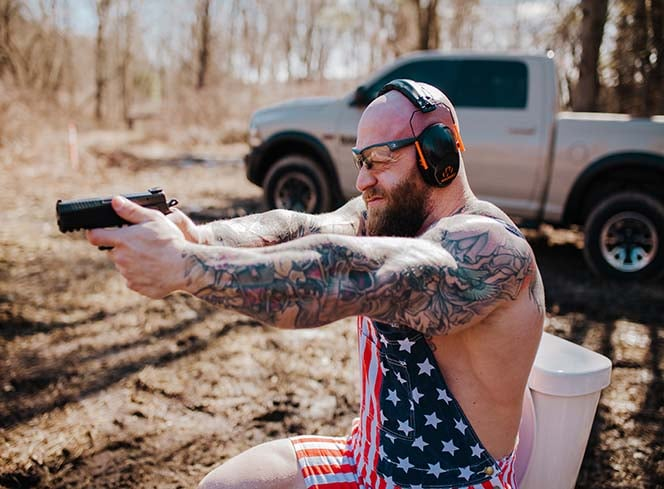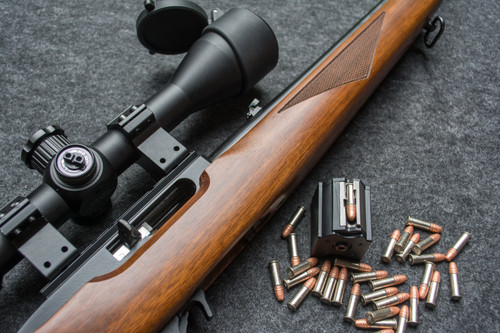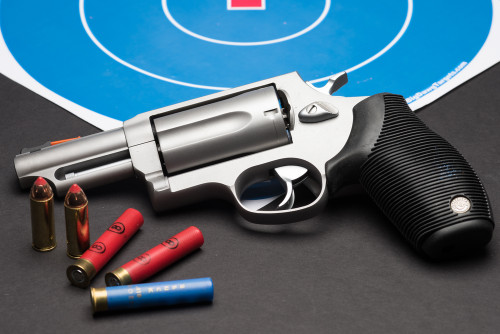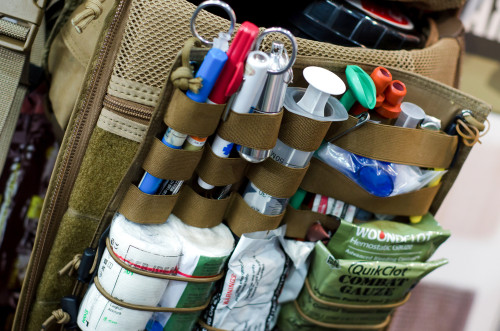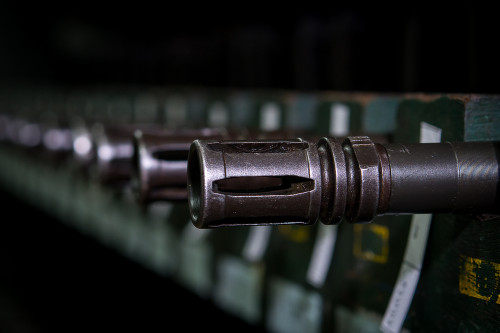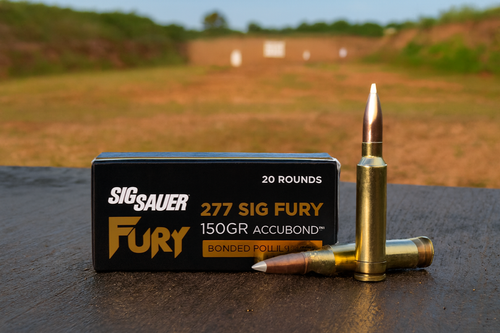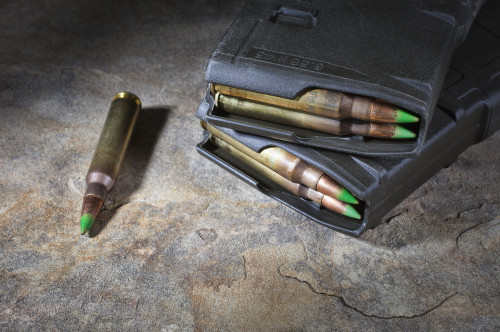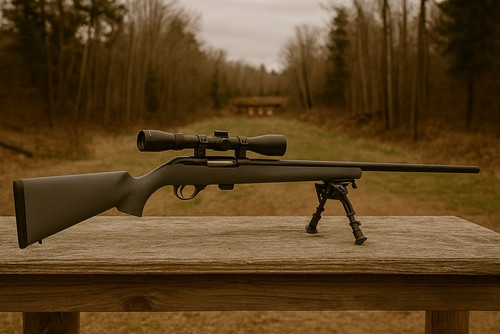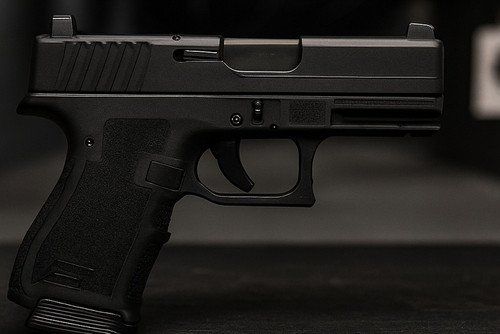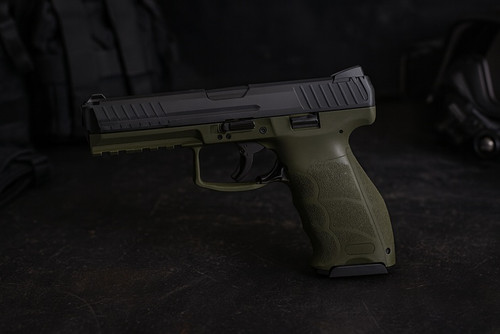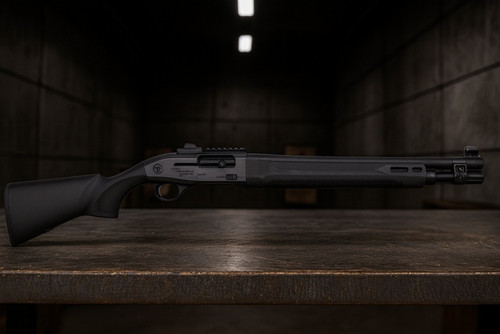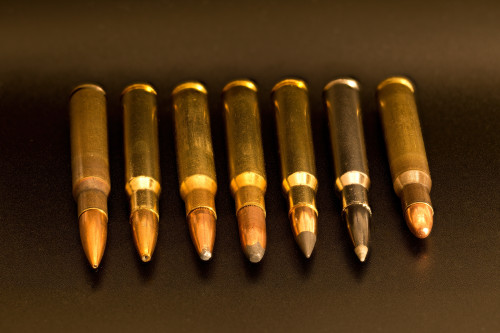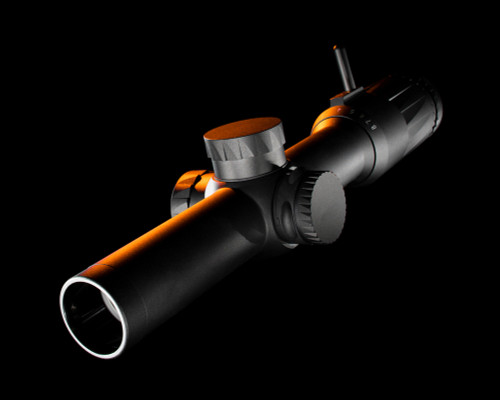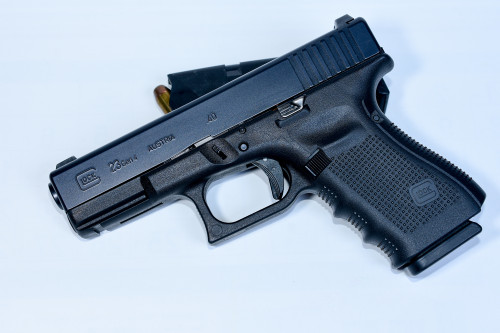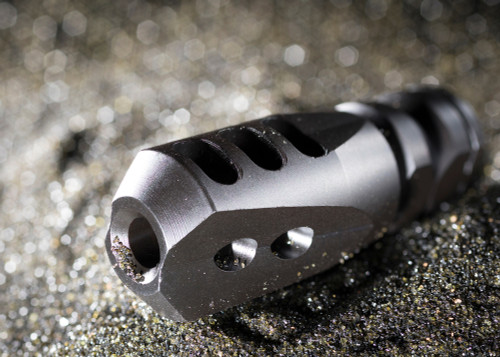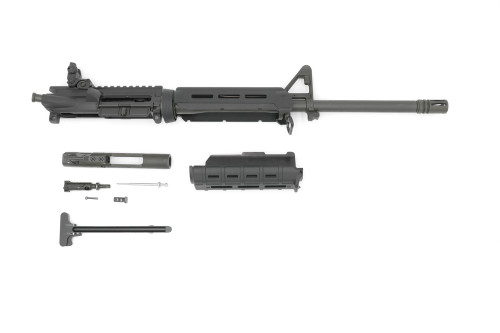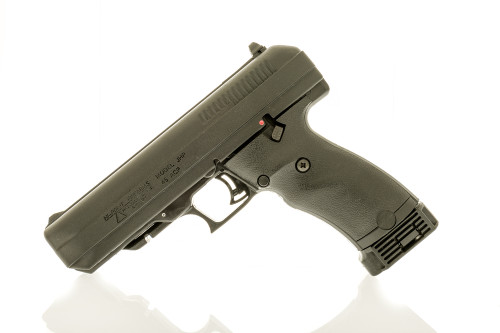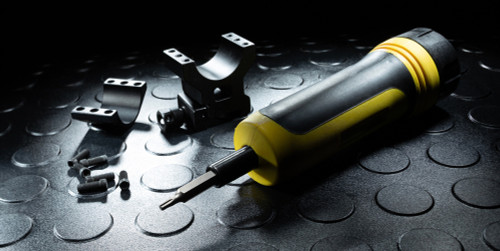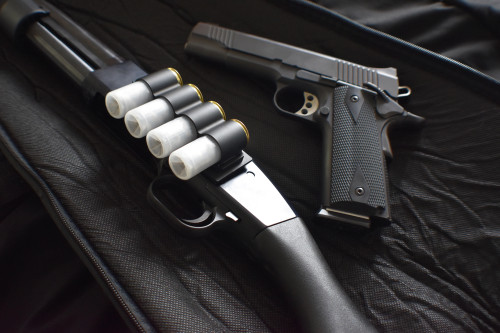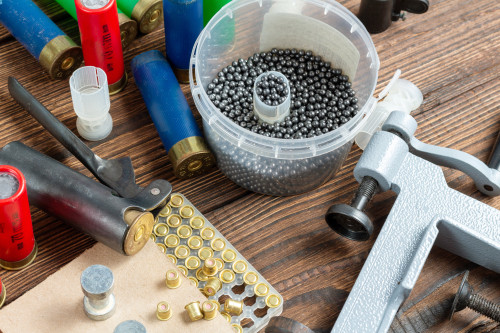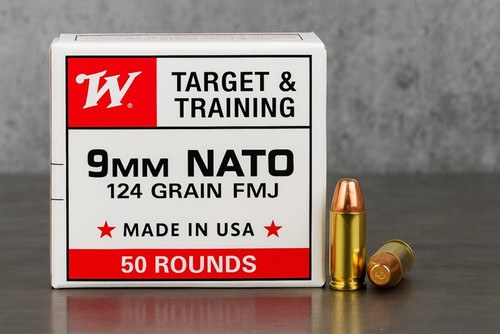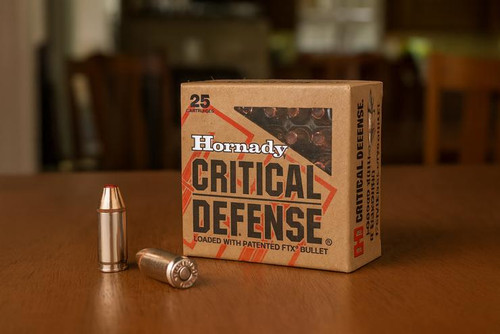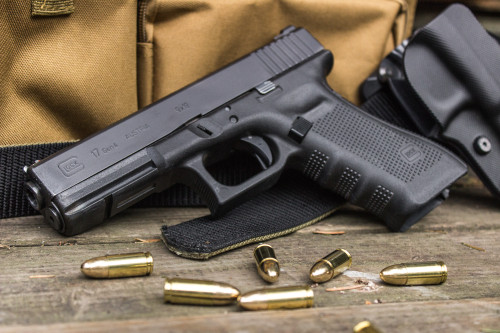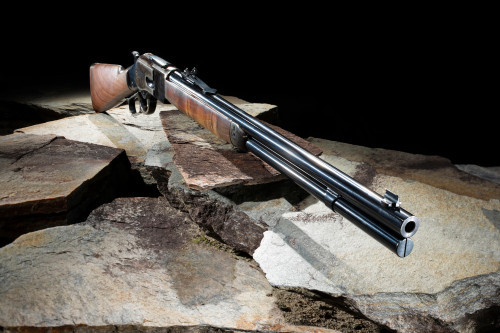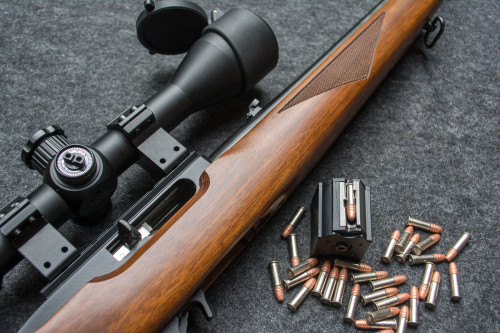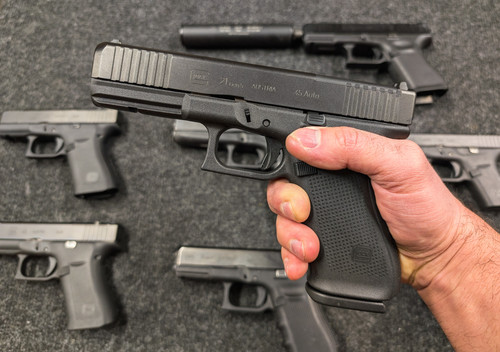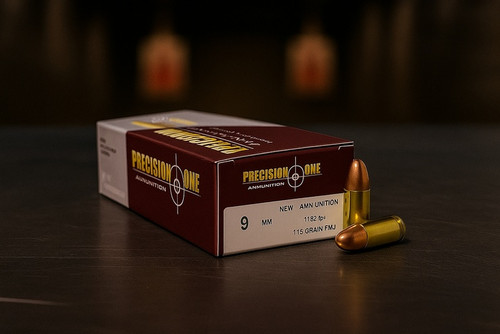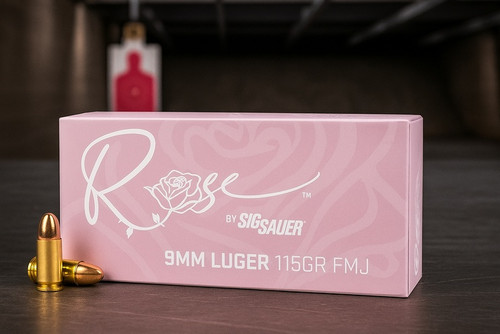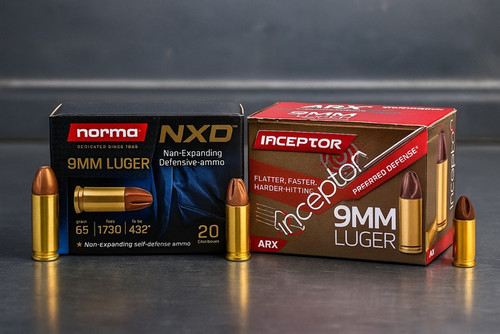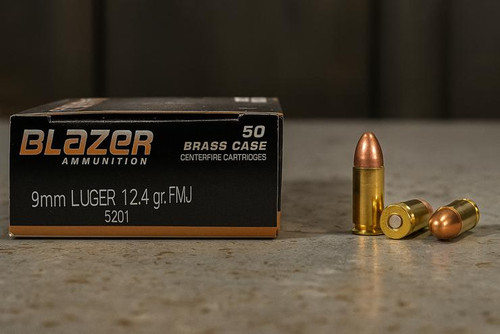In these times, most firearms purchases are born out of necessity, urgency, or patriotism. After all, exercising your right to keep and bear arms is one of the most American things you can do.
You probably didn’t think much about the country of origin when choosing your first gun. Most likely, you wanted performance and reliability, and the gun’s origin was hardly a concern, compared to the need to defend yourself in dangerous situations. Odds are, that first defensive firearm of yours was a 9mm pistol — probably made by GLOCK out of Deutsch-Wagram, Austria. (Yes, ironically the most popular handgun in the United States and the world is made by an Austrian company).
For your second gun (and beyond), you might want something that better reflects the American ethos. With the financial challenges we all face these days, you really want your hard-earned dollars to go to Americans and help sustain our country’s economic might. But just because a product has an American-sounding name, it doesn’t necessarily mean it’s made in America.
You’ll see this a lot on Amazon. A flashlight manufactured in Shenzhen, China will bear the Duracell logo, since it’s cheaper to make flashlights in China than here in the US. An Emerson weather radio hails from a similar location, despite the name’s roots in American history.
It’s the same for firearms. Springfield Armory (based in the United States) sources most of its modern striker fired from HS Produkt in Croatia (although most of their rifles and the 1911s are made in the US). Rock Island Armory (not the auction house) makes firearms in the Philippines (even though they built a lot of 1903s for both world wars). Bersa sounds vaguely American, but is actually based out of Argentina.
If you want to buy a truly American-made gun it will take research. A lot of seemingly American firearms companies don't openly broadcast where they manufacture, since it would detract from their brand’s reputation. That’s why our team at Pro Armory did the research for you. Let's look at where some of the top gun brands manufacture their products so you can make a more intelligent (and patriotic) decision.
(Source: https://www.battlefields.org/learn/revolutionary-war/battles/lexington-and-concord)
History of American-Made Gun Brands
Whether we want to admit it or not, the first firearms technically originated in China during the thirteenth century. Called the shǒuchòng or “hand cannon,” the innovation spread west, popping up in the early fourteenth century, when German knights attacked a town in what is now Northern Italy.
Later, England, France, and Italy lead the way in developing pistols. For a long time, guns were something only the military or the rich nobles of Europe possessed, since the serfs and peasants couldn’t afford them (if they could even legally have them).
How Guns Founded America
Of course, everything changed as the Battle of Lexington and Concord touched off the American Revolution on April 19th, 1775. Unable to obtain English armaments, American gunsmiths stepped up their game, rapidly becoming experts in the field out of necessity. The independence of a nation was on the line, and the key was equipping American soldiers and citizens with the best domestically produced weapons.
As we know, their efforts were successful. In a real sense, our nation was founded because of firearms. As the meme says, we didn’t negotiate terms with the British, we shot them.
American Innovation: Colt, S&W, and More
The traditions of craftsmanship and gunsmithing continued as our young nation grew and expanded westward. American citizens and military members alike needed quality firearms. These were the core brands that paved the way for the American made guns we know today:
- Springfield - Originally established in 1777 by George Washington, Springfield holds a storied place in American history as the nation's first armory. It is renowned for producing the muskets and rifles that armed American soldiers in numerous conflicts and quickly became synonymous with reliability and innovation. One of its most famous designs, the M1903 Springfield, became a standard-issue rifle for the U.S. military in both World Wars.
- Colt - Samuel Colt, whose name became synonymous with the revolver, produced some of the most legendary firearms in the world at the time. A Colt pistol could even fetch a premium price in Europe, especially amongst the gentry. Colt’s pioneering of new mass manufacturing methods allowed for the rapid adoption and production of John Moses Browning’s M1911. This led to the venerable .45 ACP handgun becoming the standard sidearm for the US armed forces for nearly eight decades.
- Smith & Wesson - Horace Smith and Daniel B Wesson improved on Colt’s revolver design, with their Model 1 revolver enjoying extreme popularity for self-defense, especially as the Civil War began. Ever responsive to the needs of the American public, Smith & Wesson has been solidified as a truly iconic manufacturer of American-made guns.
- Browning - In the late 19th century, Belgium’s Fabrique Nationale (FN) hired John Moses Browning to improve their technical prowess, since European gunmakers weren’t up to the task (save for competitors like Georg Luger). During his long tenure as one of the world’s eminent firearms designers, Browning developed the Browning action, which forms the basis of nearly every modern semi-automatic pistol’s operation. Nearly 100 years after his death, his influence is still felt amongst the world’s firearms manufacturers. Modern firearms designers such as the legendary Eugene Stoner (inventor of the AR-15) and Gaston Glock stood on the shoulders of giants like Browning.
- Remington - Founded in 1816 by Eliphalet Remington, Remington Arms produced some of the most defining firearms and ammunition calibers in history. From weapons like the Remington Rolling Block carbine to the .223 caliber rifle round, the original load for the AR-15, “Big Green” dominated the market for nearly 200 years. Though Remington as we know it became defunct in 2020, the brand is now operated by Roundhill, and its ammunition manufactured by Vista Outdoor.
America’s Firearms Reputation
With America’s history and global influence, it’s little wonder that the domestic firearms market still has an appetite for our homegrown firearms. While the arcane system of firearms import laws and regulations have ensured our market has a degree of protectionism, the simple fact is that American-made guns are second-to-none in quality and performance.
That protectionism has encouraged foreign firearms makers to set up manufacturing operations right here in America. In some cases, they’ve set up shop on American soil to compete for desirable US military and government contracts. By and large, “Made in the USA” laws ensure that our military acquire equipment from American manufacturers as much as possible, but there is wiggle room for allied nations operating here in the US.
Additionally, the relative ease of setting up a lawful firearms manufacturing operation in the United States has spurred all sorts of boutique gunmakers to spring up around the nation.
Benefits Of Choosing American-Made Guns
To be clear, there’s nothing wrong with buying a gun that’s made wholly or in-part overseas. Glock has a long-proven reputation for reliability, and while it might have a grip that’s a bit too blocky, several Glock models do work great for self-defense. The idea that all parts made overseas are cheap or poor quality is just a myth that should be dispelled.
Sure, we’ve all bought cheap stuff made in China. But we’ve also bought cheap stuff made in the USA and several other countries. If the manufacturer doesn’t spec out their parts right or sources poor quality materials, that’s on them for being cheap. But plenty of manufacturers source decent quality materials from China and other countries (and pay to manufacture them there), and still produce great guns.
At the same time, to say there’s a real benefit to choosing an American-made gun for your inventory and collection is an understatement.
American Craftsmanship
When you buy American, you’re not only benefiting from centuries worth of experience, culture, pride, and craftsmanship, you’re contributing to the lifeblood of our economy. As the dynamics of global manufacturing have changed, a good portion of the light and heavy manufacturing industry left in this country is involved in the production of quality firearms.
You aren’t just buying an American-made gun, you’re making a statement about your values.
Stateside Customer Support
Unlike with other manufactured goods, when you buy an American-made gun, you can rest assured that post-sales support and upgrades are easily accessible and handled domestically. You aren’t on a chat with a random tech agent in Southeast Asia; you’re speaking with an American, usually a fellow firearms and Second Amendment enthusiast. You’re not talking to “Employee 12837” — you’re talking with Bill from Smith & Wesson, a guy who lives in Tennessee (often with real-world product experience).
Newer Technology
American-made firearms often feature the latest and greatest in engineering concepts, ergonomics, and technology. This is often a fringe benefit of our vast military-industrial complex. Manytimes, firearms functions and materials trickle down to the citizen sector, at least in small arms. A new accessory, material, or coating is produced for a military firearm, and after years of real-world testing on duty or in combat, a civilian weapon will embrace those same concepts.
The reverse happens as well, as with red dot optics for pistols. Originally developed for competitive shooters, the red dot optic found its way onto the sidearms of military and police users. Where a cop on patrol would once only sport a GLOCK 17 pistol with nothing attached, a beat officer now often carries a department-issued pistol with a Trijicon red-dot sight and even a Surefire weapon-mounted light.
By purchasing American-made guns, you’re not only supporting American innovation and ingenuity, you’re supporting the ability for our nation to equip our military and law enforcement with the best tools around.
With all that in mind, what are the top American-made gun brands — and are they truly American?
Colt Viper (Source: https://www.colt.com/)
Colt
You’re probably aware of the old maxim: “God created man, Samuel Colt made them equal.”
Colt popularized this notion by producing some of the most iconic firearms of the day, such as the Single Action Army revolver. With innovative mass manufacturing techniques that predated Henry Ford’s assembly lines, Colt churned out pistols by the caseload for both citizens and the US military.
Colt’s ability to produce quality firearms at scale led Eugene Stoner’s Armalite (inventor of the AR-15) to sell the AR-15 design to Colt in order to equip the military (in the form of the M16). This also satisfied public demand for the rifle, since Colt could meet the standard in high volumes.
Though Colt mostly does mass production of M4s and AR-15s for military and law enforcement customers, their dedication to quality shines in their classic line of revolvers. Wheelguns like the Colt Python are produced in short runs and highly sought after by collectors and enthusiasts around the nation. Colt also produces a great “benchmark” AR-15 for civilians, made to the same exacting tolerances of their military cousins. Though FN produces the lion’s share of M4s these days, Colt has a small allocation of the production contract, mainly to keep the relationship with the military alive.
Is Colt Truly American-Made?
In February of 2021, Colt was acquired by the CZ Group out of the Czech Republic. No stranger to the manufacturing of quality firearms like the CZ 75 pistol, CZ has assured the American firearms scene that Colt’s traditions and Hartford CT-based American workforce will remain intact.
So far, CZ has held true to their word and the Colt factory in Hartford is running better than ever, supported by American expertise and tradition. CZ even extended Colt’s expertise and branding to some of their other assets around the world.
S&W M&P 9 (Source: https://www.smith-wesson.com/products/pistols)
Smith & Wesson
The iconic brand of Smith & Wesson is a firearms company that lives and breathes the red, white, and blue. With Horace Smith and Daniel B Wesson pioneering the concepts of the modern revolver almost two centuries ago, the company has established its pedigree firmly as one of the preeminent names in American firearms craftsmanship and engineering.
Cutting their teeth during the Civil War, Smith & Wesson revolvers were sought by soldiers of both the blue and gray for self-defense purposes. After the war, the company rapidly shifted production to larger caliber revolvers more suitable for use out in the frontier lands, starting with the Model 3. In 1899, the company introduced the .38 Military & Police revolver, which became a standard sidearm of US law enforcement agents for the bulk of the 20th century, proving once again the longevity of successful American-made firearms.
At the dawn of the 21st century, Smith & Wesson jockeyed for position with European rivals such as GLOCK. After changes in ownership, the company found its groove again and introduced new product lines, such as the M&P series of semi-automatic pistols — a favorite among both armed citizens and law enforcement.
Is S&W Truly American-Made?
Currently, Smith & Wesson has enjoyed record sales of its pistols, revolvers, AR-style rifles, and new M&P 12 shotgun. In response, the company pulled up stakes from its historical home in Springfield, Massachusetts, and relocated most of its manufacturing operations to the more gun-friendly state of Tennessee. Of course, they still make their guns 100% in the USA.
Ruger Mini-14 (Source: https://ruger.com/products/mini14/overview.html)
Ruger
Compared to Colt and Smith & Wesson, Ruger is the new kid on the block. Founded in 1949 as Sturm, Ruger & Company by Alexander Sturm and Bill Ruger, the company started in a small machine shop in Southport, Connecticut. Soon after, Ruger designed the company’s first pistol, the Ruger Standard, a .22 LR handgun that combined the looks of the German Luger pistol and the Colt Woodsman. The pistol was so successful that Ruger became known for its quality American-made .22LR pistols.
Ruger also introduced the iconic 10/22 series of rimfire rifles in 1964. Much like the Ruger Standard (and later the Mark IV), the 10/22 line of rifles became the de facto standard for .22 LR rifles, and remains so to this day.
Of course, Ruger is no stranger to firearms in calibers outside of .22 LR. Their GP100 revolvers in calibers such as .357 Magnum, 10mm, and other popular pistol cartridges have remained steady sellers.
Additionally, Ruger developed iconic rifles such as the Mini-14. Offered as an alternative to the AR-15, the Mini-14 is also chambered in 5.56mm. Instead of the black-on-black aesthetic of most AR-15s, the Mini-14’s aesthetic is more traditional, with a wood stock and lighter finish on the steel.
Is Ruger Truly American-Made?
With their strong catalog of rimfire weapons, revolvers, semi-automatic pistols, and centerfire rifles, Ruger actually produces the most firearms in the US on a year-to-year basis, with close to two million manufactured per year.
Ruger also pays attention to the American public’s firearm buying habits. To take advantage of demand, Ruger produces AR-15 variants, including the AR-556 — usually sourced from their Mayodan, NC location. While Ruger isn’t a “top of mind” brand for AR-15s, the real fans of the platform know you can’t go wrong with an American-made Ruger AR-15. It’s known for its quality, robustness, price, and attention to detail.
Remington Model 700 Bolt-Action (Source: https://www.remarms.com/rifles/bolt-action/model-700/)
Remington
No discussion of American firearms would be complete without mentioning Remington. Founded in Ilion, New York in 1816, Remington Arms produced some of the most defining firearms and ammunition calibers in history. With notable firearms like the Rolling Block Carbine, Remington became one of the premiere American firearms manufacturers.
As the US entered World War I, Remington established itself as one of the most prolific manufacturers of firearms and ammunition for the war effort. Soon after the war, Remington was purchased by DuPont, which leveraged its chemical expertise into improving their formulations of gunpowder. The combined company scooped up the Peters Cartridge Company, which solidified “Big Green'' in the ammunition space as well.
In 1940, the US Army tapped Remington to construct and manage a massive ammo plant to produce products for the looming Second World War. Located in Missouri, the Lake City Army Ammunition Plant (LCAAP) produced untold billions of rounds of ammunition in a wide variety of calibers, aiding our efforts in the war immensely. To this day, the LCAAP still produces ammunition for our fighting forces, with the surplus production sold on the open market to commercial purchasers. Of course, Remington also designed the ammo for these efforts with the .223 Remington (a near-twin of the 5.56 NATO cartridge). Fast and accurate, .223 Remington became the first standard caliber for the then-new AR-15 rifle.
Is Remington Truly American-Made?
Like many American firearms companies, Remington has changed hands a few times in its evolution. In the early 2000s, the company bought a firm called Freedom Group, which also acquired companies such as Bushmaster, DPMS, and suppressor maker AAC. The combined brands fell under the umbrella of the Remington brand, creating a unified family of quality firearms, ammo, and accessories.
Through most of the last decade, Remington remained under the Freedom Group umbrella, until recently when the assets were sold off. The firearms division was acquired by Roundhill, and the ammunition business was acquired by Vista.
But this was far from a disaster. This move ensured the continuing success of Big Green, with the firearms business relocating to Alabama and a new research facility being constructed in LaGrange, Georgia. The ammunition will also continue to be produced in a factory in Lonoke, Arkansas. The demand for Remington ammunition has been so great that the factory currently runs around the clock with new, state-of-the-art machinery, meeting the demand for quality American-made firearm products.
So, yes. Remington is (and probably always will be) American-made.
Mossberg Pump Action (Source: https://www.mossberg.com/firearms/action/pump.html)
Mossberg
Some of the most successful industries in the United States were established and enhanced by immigrants. The firearms industry is no exception. Enter Mossberg.
With their iconic blue and yellow boxes stylized like the Swedish flag, it comes as no surprise that the company was founded by a Swedish immigrant. Established in 1919 by Oskar Fredrick Mossberg, the company was started after Mossberg found himself at a loose end after World War I. The firearms company he worked for at the time (Marlin-Rockwell) had gone out of business, leaving him unemployed. But he had a family to feed, and his entrepreneurial spirit took over. Soon after, Frederick and his two sons (Iver and Harold) founded O.F. Mossberg & Sons in a small loft located in New Haven, Connecticut.
Their first product was the Brownie, a simple .22 pocket pistol designed for hunters and trappers to humanely kill wounded and trapped game. The pistol proved successful, and Mossburg produced over 37,000 from 1920-1932. They used the fortunes from that gun to rapidly expand the company, producing .22 LR rifles for both citizens and military training.
Sadly, Oskar Fredrick Mossberg passed away in 1937, just 18 years after the company was founded. However, the company remained in family hands, with Harold Mossberg taking over and guiding his father’s company into World War II. During that time, the Mossberg factories produced more training rifles for the military, as well as critical components for the prolific M2 machine guns utilized by every branch of the US armed forces throughout the war.
Post-war, Mossberg continued to produce quality American-made guns, culminating with the iconic Model 500 shotgun. Available in 12 gauge, 20 gauge and .410, the Model 500 is a default choice for those looking for a high-quality, reliable shotgun for sport and defense. Robust and durable, the Mossberg 500 has even been adopted for military service as a breaching shotgun, often called the “master key” by soldiers.
Is Mossberg Truly American-Made?
Today, the family-owned Mossberg continues to produce .22 LR rifles, the Model 500 shotgun, the MC2c 9mm handgun, and many other types of American-made guns. Though the company still remains incorporated in Connecticut, all firearms manufacturing has shifted to the great and gun-friendly state of Texas, further solidifying Mossberg as a top producer of American-made firearms.
Kel-Tec P50 (Source: https://www.keltecweapons.com/)
Kel-Tec
Based out of Cocoa, Florida, Kel-Tec is another rather young producer of American-made guns. Founded in 1991 by Swedish immigrant George Kellgren, Kel-Tec is known for producing some rather innovative firearms.
First designing firearms for Husqvarna and Interdynamics, Kellgren cut his teeth by creating the famous TEC-9 9mm pistol. Though the TEC-9 eventually ended up being produced in Miami by Carlos Garcia’s Intratec, Kellgren leveraged his experience when establishing Kel-Tec in Central Florida.
Kellgren’s genius was in improving existing concepts in firearms design and combining them into new firearms that established a new market niche. Not content with just designing basic handguns, Kellgren rapidly established his company’s reputation by designing many unique and notable firearms, such as the P3-AT pistol, one of the lightest and most-concealable .380 pistols on the market. Prior to the 2003 introduction of the P3-AT, there simply weren’t many micro-sized centerfire pistols at all.
Kel-Tec also developed the SUB-2000. A lightweight and easy-to-use 9mm pistol-caliber carbine, the SUB-2000 can be folded in half for easy storage and transport. The firearm can be rapidly deployed from its folded position, making it an ideal “truck gun.”
Kel-Tec’s most recent firearm is the P50 pistol, chambered in the FN 5.7x28mm caliber and using P90 magazines, which lay on top of the firearm, using a rotating “turntable” feed system to chamber rounds. Lauded as “crazy” the P50’s status as a “meme gun” and its surprising accuracy quickly made it a crowd favorite for the American gun-buying public. American firearms innovation is about taking risks, and the P50 is definitely no exception.
Is Kel-Tec Truly American-Made?
One could reasonably argue that Kel-Tec “stole” a foreign idea when they chose to make their SUB-2000 compatible with GLOCK magazines. However, their firearms are all completely sourced and made in the Gunshine State in Cocoa, Florida. Kellgren may hail from Sweden, but he and Kel-Tec are true-blue American in spirit and risk-taking, producing some of the most interesting and useful firearms on the market.
Daniel Defense DDM4 (Source: https://danieldefense.com/wire/american_made)
Daniel Defense
Founded by Marty Daniel in 2002 to produce rail systems and accessories for the military, Daniel Defense evolved into a full-fledged firearms manufacturer with the release of their DDM4 series of AR-pattern rifles — all manufactured in-house at facilities in Georgia.
Daniel Defense’s complete rifles took the market by storm, with well-financed private buyers and government entities alike seeking these premium weapons for their own use. Elite units of the US and allied militaries with their own procurement processes and budgets routinely purchase select-fire versions of the DDM4 (as well as its 7.62x51mm cousin, the DD5 series).
Of course, the US civilian market also holds Daniel Defense in high regard. Known for their accuracy, reliability, ergonomics, and lightweight, Daniel Defense rifles command a top premium in the firearms market, with basic packages often starting at well over $2000.
Is Daniel Defense Truly American-Made?
Daniel Defense isn’t just an American AR-15 company — they’re a testament to the USA’s leadership in the firearms space. While a Daniel Defense rifle may cost $2000 - $3000 here in the US, it could easily cost triple that in Eastern Europe, where well-heeled firearms enthusiasts will pay top dollar for the brand and quality.
The world knows America’s tradition of firearms manufacturing produces superb results. Daniel Defense is now undeniably part of that tradition.
Sig Sauer P220 (Source: https://www.sigsauer.com/firearms/pistols/p220.html)
SIG Sauer
With its roots in Switzerland, SIG got its start as a wagon-making company that shifted to firearms production with the M1863 rifle, built at the behest of the Swiss government. For the next one hundred years or so, SIG produced various firearms for European users, and in 1976 acquired rifle maker J.P. Sauer & Sohn, to become SIG Sauer.
In the 1980s, SIG set up an importing operation in Tyson, Virginia to facilitate the sales of the P220 and P230 models of handguns in the United States, and to provide SIG Sauer the ability to compete for US military and government contracts. This would prove useful as the P226 pistol became one of the standard sidearms of the Navy SEALS.
With the American market becoming more important to SIG, a factory and development facility was opened in Exeter, New Hampshire in 1992 to domestically produce the P229. This proved fortuitous, as the firearms market in the US was expanding dramatically due to the looming threat of the 1994 Assault Weapons Ban. Thankfully, the ban only lasted for 10 years, and SIG was ready for the sunset, adding AR-15 style rifles to its portfolio and further expanding its operation in the United States, turning out thousands of American-made SIG firearms every year.
SIG’s growth continued unabated into the second decade of the 21st century, with the Exeter facility expanding rapidly and tooling up to produce suppressors, optics, and other accessories. Again, SIG’s faith in the American workforce proved well-placed, as it won the contract to produce the M17 and M18 9mm service pistols for the US military. The successors to Beretta’s M9, the M17 and M18 are based on SIG’s P320 civilian 9mm pistol, with some minor alterations to comply with military requirements for field serviceability and safety.
Is Sig Sauer Truly American-Made?
To be fair, SIG Sauer is owned by L&O Holdings of Germany, but nowadays, the bulk of SIG’s firearms production hails from the United States.
In fact, SIG Sauer USA has been tapped once again by the US Army to provide the next generation service rifle, the XM7. Chambered in the new SIG-developed 6.8x51mm cartridge, the XM7 is currently undergoing acceptance trials with the military, with hopes of deployment in the next few years.
These prime contracts and the synthesis of US citizen and professional users have made SIG’s US operation the leader in the overall SIG family. So much so that SIG globally has scaled back international production and relocated most of its capacity to the United States, owing to our manufacturing prowess and dedication to quality gunsmithing and engineering.
Though technically a European brand, it can rightfully be said that SIG Sauer is a prime producer of American-made guns and firearms accessories.
PSA AR-15 (Source: https://palmettostatearmory.com/blem-psa-pa-15-16-nitride-m4-carbine-5-56-nato-classic-ar-15-rifle-with-13-5-m-lok-rail-black.html)
Palmetto State Armory
Another true American firearms success story is Palmetto State Armory. Founded by businessman and firearms enthusiast Jamin McCallum in 2008, PSA started out in McCallum’s garage in Columbia, South Carolina, where he sold magazines and accessories via the PSA website. Soon after, the company expanded its catalog to include sales of complete firearms from other manufacturers, often at a price point well below the competition.
Since you can only force the price so much on someone else’s guns, McCallum and his team soon shifted into the business of making their own guns in the United States. With streamlined manufacturing processes and a desire to arm every American citizen, PSA is well-known for producing quality pieces at a very agreeable price point. Often, a complete in-house manufactured PSA AR-15 (which will work quite well for a citizen user) retails for less than $500.
They also make pretty good pistols, including the PSA Dagger, which is a decent alternative to the Glock 19.
PSA also explores new concepts in firearms manufacturing, often with the input of customers via their social media channels and brick-and-mortar shops throughout the Carolinas. For example, after the 2024 SHOT show, the PSA team posted several concept guns on their X and Instagram channels, asking the community which concepts they should pursue and make into complete and functional firearms.
Is PSA Truly American-Made?
As an exemplar of the ingenuity behind American-made guns, Palmetto State Armory is hard to beat, especially with their dedication to the community of armed American citizens.
However, they do sometimes outsource their barrels to FN America. While FN is technically a Belgian company, the little manufacturing they do for PSA appears to be on American soil.
Springfield Armory
George Washington originally ordered the establishment of Springfield Armory in 1777, and the name still holds a prominent place in American history as the nation’s first armory. They produced the first true contracted arms for the U.S military and continue to do so to this day.
It was the M1903 Springfield rifle that cemented Springfield’s reputation for excellence. However, in 1968, the original government-run armory closed. The Springfield Armory name was revived in the 1970s by the Reese family, a team of passionate firearms enthusiasts committed to continuing the legacy of quality American-made firearms. At the same time, the modern Springfield Armory has produced several notable firearms that blend historical craftsmanship with modern technology.
Key innovations include the M1A, a civilian version of the M14 rifle, and the XD series of pistols, which have become popular for their reliability and performance. Springfield Armory also developed the SAINT series of AR-15 rifles, catering to a wide range of shooters.
Today, Springfield Armory continues to uphold its tradition of excellence, manufacturing many firearms in Geneseo, Illinois. Civilians, law enforcement, and military personnel all use Springfield firearms. They are also involved in American politics and 2nd amendment advocacy to varying degrees. However, many of Springfield Armory's popular firearms are actually designed and manufactured by HS Produkt in Croatia, including the XD series pistols and the Hellion rifle. For some models, major components are made in Croatia and then imported to the U.S. for final assembly with some American-made parts.
Is Springfield Armory Truly American-Made?
While Springfield Armory was technically the country’s first Armory, the current company has no real direct connection to that historical entity.
More importantly, its manufacturing practices aren’t strictly American anymore. Seeing as the Hellion rifle and many of their modern striker-fired pistols are largely made in Croatia, you can’t just buy anything from Springfield Armory today and expect to be fully supporting the American economy. However, their 1911s, other pistols and revolvers, and pretty much all of their rifles (except the Hellion) are made right here in the states, adhering to the tradition of American firearms manufacturing.
TLDR: With Springfield it’s a bit complicated. They’re an honored player for their history, but not all of their guns are made on American soil today.
Foreign Brands On US Soil
Though technically a foreign brand, SIG Sauer was worth its own separate mention due to the sheer size and scope of its US operation. However, several other foreign-owned brands also have some degree of manufacturing presence on US soil.
GLOCK
Admittedly, the US firearms market was in an innovation gulch until Gaston Glock and his then-unusual GLOCK 17 came along. In fact, the American handgun industry is partially where it is today because of GLOCK. It took an Austrian gun maker to shake us out of our comfort zone, and the GLOCK did so with a pistol that proved ergonomic, easy to use, and easy to service. It was also quite affordable despite its high-tech polymer frame.
Recognizing the vast US market, GLOCK set up a facility early on in Smyrna, Georgia. Originally just a warehouse to receive imported GLOCKs in compliance with the law, the facility soon began to produce American-made GLOCK pistols. To keep things in sync with the mothership back in Austria, Gaston Glock demanded that each and every machine in the US factory be the same as the ones in Germany, enabling both workforces to communicate and cross-train on the same gear. These machines in the US even run on European voltages to eliminate any issues of inconsistency.
This led to the fusion of Austrian design and American workmanship, with quality GLOCK pistols being made on both sides of the pond. Remarkably, the G19X sports a USA engraving on its slide, showcasing its point of origin and quality American workmanship.
With the expansion of the US firearms market, more and more GLOCK pistols could be Made In The USA — but it wouldn’t be right to call GLOCK an “American” brand, since the parent company is decidedly European in so many ways.
FN America
Fabrique Nationale of Belgium is an interesting case of American know-how fusing with European traditions in manufacturing and gunmaking. In one sense, an American is responsible for the success of FN, with the company having hired John Moses Browning, the preeminent firearms designer of the early 1900s, to help them develop and produce new firearms for European military contracts.
It’s rather appropriate that FN returned the favor and set up a major manufacturing facility in the United States in Columbia, South Carolina. Originally established to produce the M240 machine gun for the US military, the FN America factory’s workforce now proudly turns out a whole catalog of pistols and rifles for the American citizen. Pistols such as the FNX-45, the FN 509, the FN 510, and the semi-automatic clones of the military M4 feature high in the output of the Columbia factory.
Additionally. FN America turns out firearms components such as barrels for other manufacturers. Palmetto State Armory (also in Columbia) will often procure barrels from FN for their higher-spec AR-15 and AK-style rifle offerings.
Helped by Americans, nurtured in Europe, and produced in America can sum up American-made guns from FN. But are they a truly “American” brand? It’s debatable.
Heckler & Koch
Founded at the dawn of the Cold War in what was then West Germany, Heckler & Koch established itself as one of the premiere manufacturers of firearms in the world. Pistols such as the P7 made this European marque a premium brand here in the United States. Though not a hot seller, the P7 striker-fired pistol predated the GLOCK 17 by over five years.
Plus, who can forget the MP5? This space-age submachine gun was popular with European special operations forces throughout the 1970s, and used in several high-profile incidents such as the Munich Olympics tragedy and Operation Nimrod. The MP5 caught the eye of American operators, and H&K rapidly established a foothold here in the US to cater to our military. With an import facility in Sterling, Virginia, the company produced the MP5 to satisfy the contracts of US special operations and law enforcement groups.
Demand for H&K products in the US continued to build, leading to the expansion of the Virginia import facility. H&K also produced a variety of select-fire weapons for government entities, including the H&K 416 and 417. However, for mass adoption, weapons were required to be made in the USA. With that in mind, H&K set up a new facility in Columbus, Georgia. Due to German export laws, only certain H&K military products could be produced overseas, so initially the Columbus facility only produced American versions of the HK416 (named the M27 in US Marine Corps service) and the HK417 (named the M110A1 in US Army service) select-fire rifles.
However, the Columbus facility produces semi-automatic versions of HK’s military rifles, with the semi-auto version of the 416 being called the MR556, and the semi-auto version of the 417 being called the MR762.
Bearing US rollmarks, these firearms are German-designed and American-constructed — but we wouldn’t consider H&K an “American” made gun brand.
Beretta
As one of the oldest continuously-operating companies in the world under the same ownership, Beretta has been in the gun business for over 500 years. Founded by the Beretta family during the Renaissance period in Italy, Beretta’s craftsmanship skills have only improved over their long history.
Whether it’s a handmade hunting rifle costing more than a luxury Italian car, or service pistols like the 9mm Model 92, the name Beretta is synonymous with Italian style and performance. In fact, some of Beretta’s made-to-order firearms can only be picked up in their “galleries” in Dallas and New York City.
Nonetheless, Beretta has a US footprint for manufacturing. At first, the operations were limited to producing the Model 92 pistol for the M9 military contract, and imported rifles, pistols, and shotguns through a facility in Maryland. However, with the changing political tides in that state, Beretta made the decision to relocate to Gallatin, Tennessee. They not only import their firearms through that location, but also produce new variants of the Model 92 pistol there (as well as an assortment of rifles and shotguns).
Beretta’s US management has been given free hand to actively encourage and participate in the US gun rights scene. You’ll often see Beretta sponsoring Second Amendment-friendly organizations and events. But does that make them an “American” brand for buying purposes? No, but they’re an honored guest.
Support American Firearms Manufacturers and Dealers
In the end, it’s a good practice for armed American citizens to support US firearms manufacturers, shops, and dealers. American firearms companies participate in the national scene by promoting responsible, effective firearms ownership and backing gun rights. By supporting our domestic firearms industry, we help to grow the industry and promote better firearms usage in our backyard.
Culturally, firearms are in our DNA, since our nation was founded by armed citizens. By continuing that tradition, we pay homage to those who fought and died to establish and preserve this land. Thus, we help our descendants learn about and preserve this freedom and heritage for generations to come.
At Pro Armory, we’re a veteran-operated business. Our team members share that same passion for arming American citizens with equipment you can trust to work when you need it. We also know the importance of saving money in these trying times. That’s why we offer quality ammo and accessories you can afford — because your wallet shouldn’t inhibit you from participating in your Second Amendment right.
Browse our selection of quality ammo, optics, and other accessories — and sign up for our newsletter to be notified about handgun safety and tactical training.




